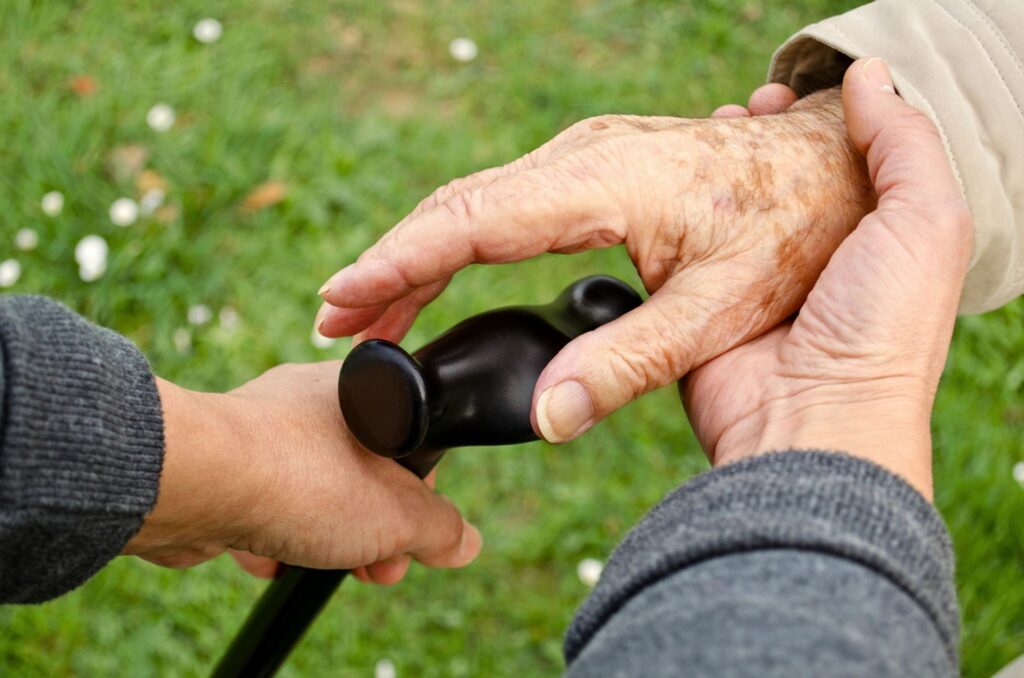Hospice for Dementia
As we age, our bodies and minds may weaken and slow down. Occasionally, we may misplace our car keys or stumble around for a name or a simple word, only to remember it later. Those are examples of typical age-related cognitive slowdowns, but they don’t usually interfere too much with daily life.
Dementia is different and often has a more profound effect on one’s ability to function. Let’s take a closer look at this condition, what hospice is, and what the benefits of hospice care for dementia-related diagnoses are.
What is Dementia?
Dementia is not a specific disease in and of itself. It is better described as a set of symptoms that include cognitive impairments in memory recall, thinking, communication, and socialization. Unfortunately, it will also interfere with the ability to perform activities of daily living such as eating, toileting, and bathing.
What Causes Dementia?
Dementia occurs as a result of the breakdown in communication of neurons in the brain. Without these vital communications in the brain cells occurring, a decline in speech, communication, concentration, information processing, and overall functions will ensue.
When certain criteria are met, a patient with dementia can qualify for hospice benefits. We will take an in-depth look at what symptoms indicate that it may be time for hospice, and how a patient can benefit from hospice care for dementia. First, let’s look at the major types and the stages of dementia.
Four Major Types of Dementia
Alzheimer’s Dementia
The most common dementia diagnosis is Alzheimer’s. Over half of all dementia-related diagnoses are classified as Alzheimer’s Dementia (AD). Today, it is estimated that greater than 6 million Americans 65 years and older are living with this condition. It has also been projected that the number may double to almost 13 million by the year 2050.
The vast majority of those affected are over the age of 75. White women, older black Americans, and Hispanics are among the adults at the highest risk for developing AD. Other risk factors include a previous family history of Alzheimer’s, poor cardiac health, and previous trauma to the brain.
Symptoms of Alzheimer’s may gradually increase and the course is often unpredictable in terms of how long each stage may last. Patients may experience the signs of AD for 4-20 years before developing severe symptoms.
Some early signs of Alzheimer’s are memory loss, changes in mood/personality, loss of interest in hobbies, normal tasks taking longer to complete, and increased anxiety/aggression. It may seem like small changes initially and may even be difficult for the patient and family members initially to notice cognitive impairment.
A few moderate signs are a marked increase in confusion/ memory loss, difficulty completing tasks that require more than one step, and the inability to recognize family and friends.
Full-time care is required for Alzheimer’s patients with severe symptoms. End-Stage Alzheimer’s will lead to the patient being bed-bound and totally dependent for all needs. This is marked by the loss of the ability to communicate, weight loss, swallowing issues, sleeping more, skin breakdown, and the loss of bowel and bladder control.
Lewy Body Dementia
When a patient displays symptoms of both Parkinson’s and Alzheimer’s, it is called Lewy Body Dementia. Particular features of this condition are drastic changes in behavior, periods of increased sleep, and increased confusion. One hallmark of this type of dementia is violent body movements that occur when the patient is asleep which is called “dream enactment behavior”. Lewy body dementia has been dubbed as a sub-type, or variant, of Alzheimer’s.
In the early stages of Lewy Body Dementia, patients can experience a wide array of disturbances such as hallucinations, delusions, and extreme behavior, which may necessitate medication. Caution is needed when treating dream enactment behavior with antipsychotics as those with this condition tend to be more sensitive to side effects from the medication.
Vascular Dementia
An unfortunate consequence of having a stroke can be the development of vascular dementia. This is the second most prevalent form of dementia. Smoking, heart disease, diabetes, stroke, high blood pressure, and high cholesterol are all risk factors. Men are typically more susceptible to this condition than women.
Another cause of vascular dementia is when patients have a succession of small strokes that go undetected. Over time the loss of neurons due to ischemia can cause this type of cognitive decline. Conversely, a single large stroke can be the sole cause of this type of dementia.
Vascular dementia symptoms overlap with signs of neurological damage. Patients with this type may have issues with mobility, weakness, and incontinence.
Frontotemporal Dementia
Typically, as seen in the first three types of dementia we discussed, patients affected are 65 and older. This type is different in that it strikes earlier, before the age of 65 and it is not usually found over the age of 75. Both men and women are equally at risk for this condition.
As its name suggests, Frontotemporal Dementia results from changes in the frontal and temporal regions of the brain. What major symptoms will develop is governed by the location of neuronal breakdown. Many will experience severe speech issues such as difficulty understanding words, forming words, and even the complete loss of speech. If their symptoms are behavior-related, they may scream or use vulgar or inappropriate words, progressing to loss of behavior control.
The four types of dementia described above are only the most common types. There are many additional types and subtypes. Most dementia-related conditions follow progressive stages of declining function. Now that we have learned a little about the types of dementia, we can look at the common stages.
Stages of Dementia
In Alzheimer’s Dementia, there are seven stages. Each stage is unique to the individual both in symptoms experienced and in the length of time that each stage lasts. Typically patients with Dementia/Alzheimer’s seek Hospice care at the advanced or end-stage.
Stage 1
Although there are already changes happening in the brain, the brain is still functioning normally. There are no symptoms that a patient would notice. In fact, it would take a PET scan to even identify the condition at this stage.
Stage 2
In this stage, a patient may start to notice something is off. The symptoms are so mild that family, friends, and even coworkers would not notice them. Forgetting names of friends, or constantly misplacing often-used items are key indicators. In general, the patient will still function normally.
Stage 3
At this point, family and close friends may start to notice small changes that are concerning. Losing keys, wallets, or other important items often is one early sign. It is becoming noticeable that the patient cannot remember names or even some words. Social skills are diminished. Having to repeat questions and forgetting something they just read are additional struggles. Early Alzheimer’s can be diagnosed at this stage.
Stage 4
Here is where the early symptoms begin to show progression. The signs are more obvious as they can interfere with work, socialization, and daily function. This is the last stage where symptoms are considered mild.
Patients will have difficulty remembering current events as well as their own personal past history. Because the patient is having many struggles with memory, comprehension, making decisions, and multi-step functions, they often will avoid socialization or mentally tasking activities. One sign of this stage is the inability to use money correctly to pay for an item at the store.
Stage 5
Symptoms in this stage are no longer mild, but rather moderate. The progressive decline has caused considerable memory-related and cognitive difficulties. Patients in this stage will need assistance with some activities.
A patient may no longer recall important information such as their current address or phone number. This can pose a danger if they are out alone and unable to find their way home. They also may not remember dates, seasons, and times, causing them to not show up to appointments on the right day or at the right time.
Stage 6
Significant signs of memory and cognitive decline happen as the condition progresses. Major changes in personality and behavior occur at this stage. Patients will need assistance with most activities including eating and toileting.
Severe memory impairment causes patients to become generally unaware. Patients may forget even their closest loved one’s names, memories shared in a lifetime, current and past events, and even where they are. They can still usually remember their own name though.
Patients will often wander and get lost at this stage. To keep them safe, they will need a full-time caregiver. Because of the marked cognitive decline, they may become easily frustrated, combative, confused, and may even have hallucinations.
Other signs at this point are inability to dress themselves properly, urinary/bowel incontinence, waking at odd hours, and repetitive activities.
Stage 7
In the final stage, all areas of life are affected, and patients require help with all aspects of daily living. Patients become more disengaged with their surroundings, socially, and even in physical changes.
Patients may experience mobility issues due to muscle breakdown, nutritional deficiencies, and weakness. They are usually fully incontinent and may have poor oral intake. Speech may or may not be present.
Because each patient experiences dementia symptoms somewhat uniquely, the timing of each stage is rather unpredictable to some point. In general, each stage progressively worsens ending in the need for total patient care.
Now that we have learned about what Dementia is and what symptoms it produces, let’s discuss what hospice is, when it is time for hospice care, and the benefits of hospice for dementia.
What is Hospice?
Hospice encompasses the services that are provided to a terminally ill patient to preserve dignity, provide comfort, and support at the end of life. It involves the patient, their family/friends, and the hospice team, all working in sync to provide compassionate end-of-life care.
In keeping with the goals of hospice, to maintain patient dignity and comfort, care can be in the patient’s own home, a personal care home, a nursing home, the home of a relative, and sometimes in a hospital or inpatient hospice unit.
The hospice team may consist of an attending physician, an RN case manager, a home health aide, a chaplain, and a social worker.
When Is It Time for Hospice Care?
As there is no cure for dementia, and it is a progressive condition, the challenging part is to determine when it is time for hospice care. Many times, patients and caregivers express that they had wished they knew all that hospice care offered sooner.
The general qualification guidelines for admission to hospice services is a physician certifying the terminal diagnoses and the course of the condition would be six months or less.
With Dementia/Alzheimer’s the most common way to determine eligibility is using the Reisburg Functional Assessment Staging Scale (FAST). This staging scale evaluates multiple aspects of physical and cognitive function. Generally, the patient will be eligible under the conditions of being incontinent to bowel/bladder, severe impairments in communication, totally dependent on a caregiver for all activities of daily living, or having a comorbid medical condition contributing to the health decline. Thankfully, hospice care is very beneficial for people diagnosed with dementia. Below are the five most common benefits.
Five Benefits of Hospice Care for Dementia
One unfortunate misconception is that hospice care is only for the final days of life. This couldn’t be further from the truth. Hospice care is designed to help a terminally ill patient have the highest quality of life they can, while maintaining dignity, and comfort for the remainder of their life.
- Better Pain Control for patient
Hospice care allows for better pain control as it is truly patient-centered. A customized care plan can include: regular evaluation by a hospice nurse, dedicated team members, keeping caregivers consistent to establish a rapport with the patient, the ability to have frequent communication with the hospice medical team, and the use of established medication protocols that can be implemented quickly. These all contribute to excellent pain control. - Better Symptom Management for Patient
There can be many different symptoms that arise such as nausea or anxiety, depending on what other medical conditions the patient has in addition to dementia/Alzheimer’s. Just as patients experience better pain control on service as a result of frequent assessments, routine nursing visits, and excellent communication from the team members, these measures will also facilitate early identification and treatment of symptoms. - Caregiver Support
Caregivers of patients with Dementia/Alzheimer’s may feel overwhelmed at times. Feelings of fatigue and burnout can occur as a result of trying to navigate the unique needs of patients with cognitive decline, especially when the patient has lost communication skills.While the number one priority is patient comfort, hospice also provides support to the caregiver through education on disease process/death and dying, comfort care, medication administration, symptom control, and practical support such as providing a home health aide to assist with daily needs such as bathing.
- Emotional Support for Family/Caregivers
Caring for a loved one at the end of life does have an emotional cost that cannot be denied. It is hard to physically care for a Dementia/Alzheimer’s patient but it can also be mentally and emotionally taxing.Hospice team members can help provide the kind of emotional support that is needed. From actively listening to a caregiver’s concerns to offering practical solutions, there are many ways hospice team members can help to relieve the stress. Social workers identify needs related to caregiver breakdown, knowledge deficits, crises that may arise, grief support, and spiritual care.
Extended family members can also benefit from the support of a dedicated hospice team. Being patient-centered also means caring for and supporting loved ones.
- Bereavement Support
A dynamic hospice team is more than just access to excellent medical care and emotional support. It also provides grief support. Social workers are patient advocates adding another layer of patient and family care by identifying the need for additional support services.The social worker can recommend spiritual support from the hospice chaplain if requested by a patient or caregiver. Spiritual care is often an important part of the dying process, and the chaplain can offer guidance and support during illness and after the patient has passed.
Hospice Las Vegas
Hospice truly is the best way to provide compassionate, patient-centered care for Dementia/Alzheimer’s patients at the end of life. If you have been searching for local support in caring for your loved one and are unsure of where to turn, then a hospice in Las Vegas may be the answer. Don’t miss out on the benefits of hospice for Dementia. Talk to your medical provider to see if it is time for hospice.
Author: Julie Chapman LVN is a nurse writer with a passion for nurturing people. With 14 years of experience, she has worked with various specialties; however, hospice is the niche she feels the most called to.
Reference Links:
https://www.cdc.gov/aging/dementia/index.html
https://www.thelancet.com/series/non-alzheimers-dementia
https://eastonad.ucla.edu/index.php/patients-caregivers/about-non-alzheimer-dementias
https://www.alz.org/alzheimers-dementia/facts-figures
https://www.nia.nih.gov/health/what-are-signs-alzheimers-disease
https://www.dementiasociety.org/definitions?msclkid=b53d521374e7194b392133a9fbe106c6
https://pallipedia.org/functional-assessment-staging-fast/
https://entirelyhealth.com/conditions/brain/7-stages-of-dementia-disease/6/






